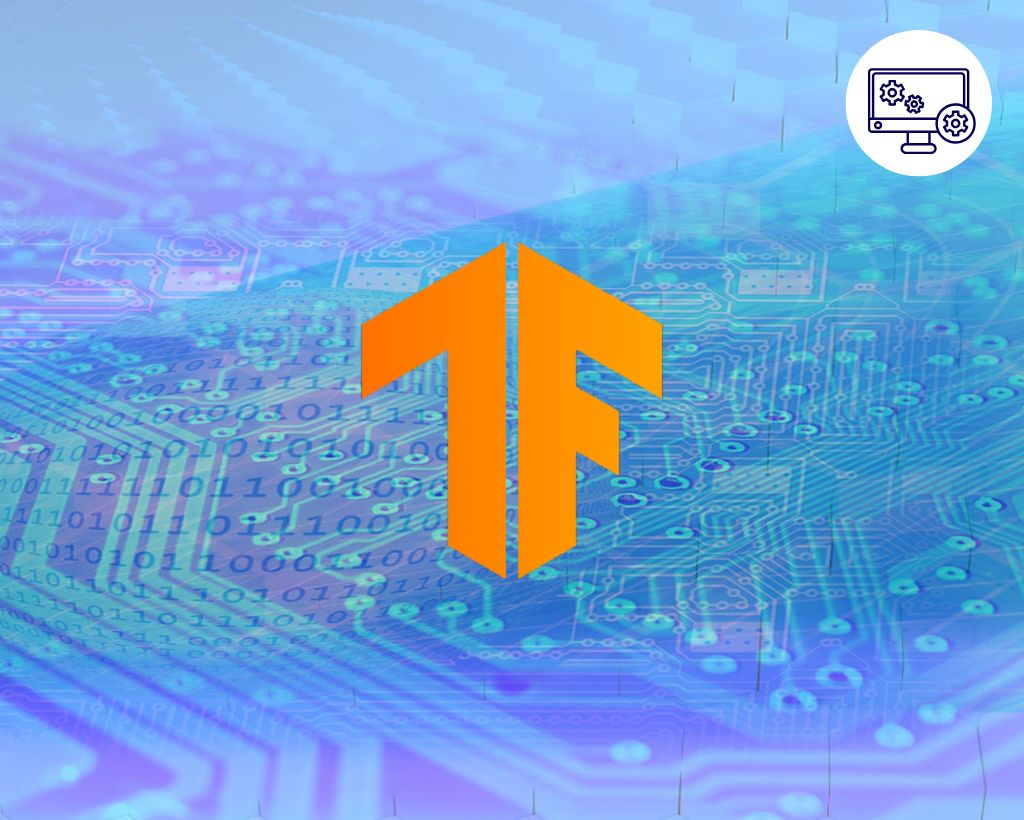أصبح الذكاء الاصطناعي والتعلم الآلي حجر الزاوية في التحول الرقمي. وأصبح اتخاذ القرارات المستندة إلى البيانات أمرًا روتينيًا في العديد من القطاعات، بما في ذلك الرعاية الصحية، والمالية، وتجارة التجزئة، والزراعة، وصناعة الدفاع، وغيرها. ولا شك أن TensorFlow هي إحدى أقوى الأدوات البرمجية التي تدعم هذا التحول. فما هو TensorFlow إذن، ولماذا يُستخدم على نطاق واسع؟ في هذه المقالة الشاملة، سنتعمق في جوانبه المتعددة، بدءًا من تاريخه وتفاصيله التقنية، وصولًا إلى حالات استخدامه وأمثلة على سيناريوهاته.
ما هو TensorFlow ومن أين يأتي؟
TensorFlow منصة تعلّم آلي مفتوحة المصدر، طورها فريق Google Brain. أُعلن عنها لأول مرة عام ٢٠١٥، وطُوّرت في الأصل كخليفة لنظام DistBelief الأقدم. طبّقت Google TensorFlow من البداية، مُصمّمةً بنيةً معياريةً ومرنة لمعالجة مشاكل الأداء وقابلية التوسع التي كانت تواجهها في مشاريع الذكاء الاصطناعي الخاصة بها. وسرعان ما اكتسبت شعبيةً كبيرةً في مجتمع الذكاء الاصطناعي، لتصبح واحدةً من أكثر مكتبات تعلّم الآلة استخدامًا في العالم. لفهم ماهية TensorFlow، من المهم اعتبارها ليست مجرد مكتبة، بل منظومةً شاملةً لتعلّم الآلة. وذلك لأن TensorFlow لا تدعم تطوير النماذج فحسب، بل تدعم أيضًا عملياتٍ مثل نشر النماذج في بيئة الإنتاج، ونشرها على الأجهزة المحمولة، وتشغيلها في السحابة.
هندسة TensorFlow: الحوسبة القائمة على الرسوم البيانية
تعتمد بنية TensorFlow على الموترات. تُعالج البيانات كمصفوفات متعددة الأبعاد تُسمى الموترات. ومن هنا جاء مفهوم "التدفق"، الذي يصف كيفية تدفق الموترات عبر رسم بياني للعقد. يسمح هذا النموذج الحسابي بإجراء عمليات متعددة في وقت واحد، مما يزيد من كفاءة الأجهزة مثل وحدات معالجة الرسومات (GPU) ووحدات معالجة الرسومات (TPU). تتيح بنية TensorFlow القائمة على الرسوم البيانية تعريفًا شفافًا وقابلًا للتتبع للعمليات الرياضية المعقدة. كما توفر ميزة كبيرة، لا سيما في بيئات الإنتاج، لتصور أداء النموذج وتصحيح أخطائه. إحدى أكثر الإجابات التقنية على سؤال ماهية TensorFlow هي: إنه محرك حسابي يعمل مع هياكل رسوم بيانية ديناميكية وثابتة تُمكّن من تدفق البيانات بين الموترات.
التدريب والاختبار والنشر: حل شامل
لا يقتصر عمل TensorFlow على بناء النماذج فحسب، بل يسهل أيضًا تدريبها وتقييمها ونشرها. تتوفر العديد من المكونات، مثل المُحسِّنات ووظائف الخسارة ووظائف التنشيط، بسهولة أثناء مرحلة التدريب. هذا يسمح بإنشاء شبكة عصبية قوية بسرعة دون الحاجة إلى كتابة كل شيء من الصفر. يتيح TensorFlow دمج النماذج المُدرَّبة بسهولة في الأجهزة المحمولة وتطبيقات الويب والبنى التحتية السحابية. يتيح TensorFlow Lite نماذج متوافقة مع الأجهزة المحمولة، بينما يتيح TensorFlow.js حلول الذكاء الاصطناعي التي تعمل مباشرةً في المتصفح. أما على مستوى السحابة، فيُمكن التدريب الموزع على مجموعات بيانات ضخمة بفضل التكامل الوثيق مع Google Cloud AI.
حالات استخدام TensorFlow في الحياة الواقعية
يجب الإجابة على سؤال ماهية TensorFlow نظريًا وعمليًا. لذلك، من الضروري تقييمه من خلال حالات استخدام واقعية: • **التعرف على الصور:** في مجال الرعاية الصحية، يمكن اكتشاف التشوهات في صور الأشعة السينية والرنين المغناطيسي والتصوير المقطعي المحوسب. يُستخدم TensorFlow في التشخيص المبكر لأمراض مثل السرطان من خلال خوارزميات تصنيف الصور. • **التعرف على الصوت:** أصبح المساعدون الافتراضيون وأتمتة مراكز الاتصال وتطبيقات الإملاء أكثر دقة بفضل TensorFlow. على سبيل المثال، يمكن تدريب الأنظمة التي تنسخ أمرًا صوتيًا يسمعه ممثل خدمة العملاء باستخدام TensorFlow. • **التنبؤ المالي:** يمكن تطوير نماذج تنبؤية تعمل على بيانات السلاسل الزمنية مثل أسعار الأسهم وأسعار الصرف أو درجات الائتمان باستخدام TensorFlow. • **القيادة الذاتية:** تتطلب الشبكات العصبية التي تستخدمها شركات مثل Tesla خوارزميات معالجة الصور للتعرف على عناصر مثل الطرق وإشارات المرور والمشاة. يلعب TensorFlow دورًا رئيسيًا في هذا المجال. • **معالجة اللغة الطبيعية:** من أنظمة روبوتات المحادثة إلى أدوات التلخيص التلقائي، يمكن تطوير أي تطبيق قائم على نموذج اللغة بسهولة باستخدام TensorFlow.
لماذا تختار TensorFlow؟
فلماذا يبرز TensorFlow كثيرًا في حين تتوفر مئات من مكتبات التعلم الآلي؟ هناك بعض الأسباب الرئيسية لذلك: • **النمطية:** يُسهّل TensorFlow بناء أنظمة كبيرة من خلال دمج مكونات صغيرة في مشاريع معقدة. • **الأداء:** بفضل دعمه لوحدة معالجة الرسومات (GPU) ووحدة معالجة الرسومات (TPU)، فإنه يُقدم نتائج سريعة حتى على مجموعات البيانات الكبيرة جدًا. • **المجتمع والموارد:** يدعم TensorFlow مجتمع مطورين كبير ووثائق مفصلة ومواد تدريبية. • **الشمولية:** يوفر بنية تحتية تغطي جميع العمليات من تطوير النموذج إلى الإنتاج. • **التوافق:** يعمل مع لغات مثل Python وJavaScript وC++ وSwift. لهذه الأسباب، فإن سؤال "ما هو TensorFlow؟" هو في الواقع إجابة على سؤال "من أين أبدأ في التعلم الآلي؟" للعديد من المطورين. [
ماذا يعني التعلم العميق؟ ](https://plusclouds.com/tr/blogs/deep-learning-nedir-deep-learning-ve-machine-learning-arasinda-ki-farklar-nelerdir) يمكنك أيضًا الاطلاع على مقالتنا بعنوان.
قم بتعزيز مشاريع TensorFlow الخاصة بك باستخدام PlusClouds
 لا يعتمد نجاح مشروع الذكاء الاصطناعي على كتابة النموذج بشكل صحيح فحسب، بل يعتمد أيضًا على تشغيله على البنية التحتية المناسبة. يُعد TensorFlow مثاليًا لتطوير النماذج التي تتطلب قوة معالجة عالية. ومع ذلك، يتطلب تدريب هذه النماذج ونشرها في بيئة تشغيلية موارد خادم كبيرة. وهنا يأتي دور PlusClouds، حيث يقدم حلولًا سحابية مُحسّنة لمشاريع الذكاء الاصطناعي. فهو يوفر للمطورين الذين يعملون مع TensorFlow خوادم افتراضية مُزودة بوحدات معالجة الرسومات، وقابلية توسع تلقائية، وبنية تحتية للشبكة منخفضة زمن الوصول، مما يضمن أداءً فائقًا في مرحلتي التدريب والإنتاج. إذا كانت النماذج التي تُطورها باستخدام TensorFlow تتطلب بنية تحتية قوية، فننصحك باستكشاف المنصات المُتوافقة مع الذكاء الاصطناعي التي تُقدمها PlusClouds. لمزيد من المعلومات: [
PlusClouds ](https://plusclouds.com/us/cloud/storage)
الأسئلة الشائعة
ما هو TensorFlow؟** TensorFlow هي مكتبة تعلّم آلي مفتوحة المصدر من تطوير جوجل، تعمل مع رسوميات تدفق البيانات. تُستخدم بكثرة في تطبيقات التعلم العميق. **هل يُستخدم TensorFlow مع بايثون فقط؟** لا. على الرغم من أن بايثون هي اللغة الأكثر استخدامًا، إلا أن TensorFlow يدعم أيضًا لغات مثل JavaScript وC++ وJava وSwift. **ما أنواع المشاريع التي يمكن إنجازها باستخدام TensorFlow؟** يمكن تطوير مشاريع باستخدام TensorFlow في مجالات عديدة، مثل التعرف على الصور، ومعالجة الصوت، ومعالجة اللغات الطبيعية، والتنبؤ المالي، وأنظمة التوصية. **هل تعلم TensorFlow صعب؟** تعلم TensorFlow ممكن تمامًا لمن لديه معرفة أساسية ببايثون. واجهات برمجة تطبيقات مبسطة مثل tf.keras تجعل البدء أسهل. **هل TensorFlow مدفوع؟** لا. TensorFlow مجاني ومفتوح المصدر تمامًا، ويمكن للمطورين استخدامه وتعديله وتوزيعه بحرية.
خاتمة
في هذه المقالة الشاملة، حاولنا الإجابة على سؤال "ما هو TensorFlow؟" من جميع جوانبه. إذا كنت تسعى إلى تحقيق تقدم ملموس في مجال الذكاء الاصطناعي، فإن تعلم TensorFlow نقطة انطلاق ممتازة. لتشغيل نماذجك بأداء عالٍ، يمكنك الاستفادة من حلول البنية التحتية القوية التي تقدمها PlusClouds. إلى جانب كونها تقنية تُشكل المستقبل، تُعدّ TensorFlow أداة تُغير الحاضر. إتقانها بفعالية يُضيف قيمة ليس فقط لمسيرتك المهنية، بل لجميع القطاعات التي تُقدم حلولاً لها.


